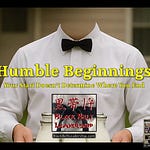If you were a child of the ’70s, ’80s, or ’90s, odds are good that you remember Schoolhouse Rock! The brainchild of David McCall, an advertising executive whose son could easily memorize song lyrics but struggled with his multiplication tables. This led to the creation of “Three is a Magic Number,” which became the foundation for the series.
Michael Eisner, an ABC programming executive at the time, saw the potential and developed it into a television series. The series initially focused on mathematics, then expanded into grammar, American history, and science. Engaging animations, memorable music, and educational content made Schoolhouse Rock! A popular and influential part of Saturday morning television for over a decade.
My granddaughter is learning conjunctions in her English class. As I heard my wife talking with her, explaining what conjunctions were and how they work in structuring a sentence, I broke into a song from 1973 Saturday morning TV, “Conjunction Junction.”
Conjunction Junction, what's your function?
Hooking up words and phrases and clauses.
I’ve got And, But, and Or, they’ll get you pretty far.
Conjunction Junction, what's your function?
Hooking up cars and making 'em function
Conjunctions are words that connect other words, phrases, or clauses together. They are essential for building complex sentences and showing the relationship between ideas. Conjunctions connect ideas, join words, phrases, and clauses, vary sentence structure, and compare or contrast the relationship between words or ideas.
The three most common adjectives, from the TV series, are “and,” “but,” and “or.” While “and” and “or” are two important conjunctions, I want to spend a few minutes focused on “but.”
By definition, “but” is a conjunction, specifically a coordinating conjunction, used to connect words, phrases, or clauses that contrast or show a relationship of opposition. It indicates a difference or an opposite idea. The primary purpose of “but” is to introduce a contrasting idea or a piece of information that is unexpected given the previous statement.
It can contrast action, qualities, or preferences.
“But” separates thoughts or ideas.
It’s a limiter, restrictor, withholder, stifler, excuse maker, compromiser, or eliminator.
“But” is a self-imposed roadblock that restricts your progress and limits your success.
Black Belt Leaders are committed to daily personal growth. It’s about a journey of positive progression where they learn, grow, improve, and expand. Black Belt Leaders understand that progress signifies a positive movement toward becoming a better version of themselves. It’s about working toward goals, developing new skills, and gaining a deeper understanding of themselves and the world around them.
Progress, to a Black Belt Leader, is a continuous journey of self-discovery and improvement, characterized by learning, evolving, and striving for Black Belt Excellence in every area of their personal and professional lives.
It’s about avoiding “The BUT Effect.”
When we were born, we experienced “The BUTT Effect” a lot. As we learned to pull ourselves up, to take our first faltering steps, we spent a lot of time teetering, falling, and landing on our butt. The good news is that it was padded, and it was close to the ground. It hurt a little, but it prevented us from experiencing serious harm as we learned to stand and walk.
This is not the “BUT Effect” I’m talking about.
The “BUT Effect” I’m talking about is a self-imposed limitation that we place on ourselves. It’s a mental barrier we’ve erected, often unconsciously, that restricts our progress, limits our potential, and prevents us from achieving our goals. The “BUT Effect” is a narrative we tell ourselves, which we believe to be true, that holds us back.
Progress ends where your BUT begins.
How often have we said something like this, “I’d really like to do this, but…” Or maybe it’s, “I wanted to become a (fill in the blank), but…” Or what about this one, “I would have, but…” “I’m trying to, but…” “I know I should, but…”
What follows our BUT is an excuse. It’s an anchor, a weight, a ball and chain, or a self-imposed roadblock that we attach to ourselves or place in our own way that halts our forward progress. It’s an attempt to rationalize, justify, or explain away our unwillingness to say, do, become, or accomplish something. It’s an attempt to excuse our inaction.
The “BUT Effect” is an attempt to shift the focus from our action (or inaction) to an external factor or other people. It’s a failure to be accountable to ourselves and those who are counting on us. It is nothing more than an attempt to minimize personal responsibility.
Avoiding responsibility for our actions, even when unintentional, hinders personal growth and learning. It can also erode trust and create resentment. The “BUT Effect” can make our explanations or apologies sound insincere.
Opportunity ends where your BUT begins.
The “BUT Effect” stifles our potential. It restricts our growth. It impedes our ability. It diminishes our confidence and undermines our belief. The “BUT Effect” shifts our thinking from “I can” to “I can’t.” Ultimately, it limits our progress and halts our success.
Think about it. When we, as children, fell on our butt, it halted our progress. We stopped moving. We faced a choice. We could stay on our butt, or we could get off our butt and start moving once again. Guess what we did?
When the “BUT Effect” shows up, we’re essentially doing the same thing, choosing to stumble, fall, and stop moving forward. We’re no longer learning, growing, exploring, creating, inventing, thinking, expanding, or enlarging.
We are not taking action. We are no longer progressing.
We have placed a roadblock in our own way, and we’ve stopped moving forward.
We’ve halted our opportunity to experience success.
We now face the same choice we faced in our childhood. Two simple options.
We can stay on our BUT and remain where we are, or we can get off our BUT and start moving once again.
We have a choice. We always have a choice.
Every choice has a consequence, whether we choose to act or not to act.
Sadly, we don’t always make the right choice.
Sometimes, we choose to stay on our BUT. When we do that, we stifle our progress and sabotage our success.
So, how do we deal with “The BUT Effect?”
First, we have to spot the BUT.
We have to develop awareness of the limiting words we may be saying to ourselves and others.
It’s easy to get comfortable with “The BUT Effect.” Remember, it’s easier to make an excuse than it is to get into that uncomfortable place where learning and growth happen. Once we start excusing our inaction, our decisions to sit on our BUT, it gets easier the next time. We need to pay close attention to the narrative we’re saying to ourselves (and others) and listen for those BUTs that keep showing up.
One way we can be more aware of “The BUT Effect” is to learn to recognize the difference between a valid concern and excuse-making. As we actively listen to the thoughts we are thinking and the words we are saying, we can train our brains to identify and alert us to our personal BUT triggers and patterns. We can also ask those who are close to us to help us become aware of the common BUT phrases that are throttling back our momentum.
Secondly, we’ve got to shrink the BUT.
We’ve got to reduce the power of limiting beliefs.
Now that we’ve learned to recognize “The BUT Effect” when it shows up in our lives, we can start to challenge the validity of our BUT statements. As we are sizing up the obstacles and challenges we face in life, we can measure them more realistically and less catastrophically. Not every situation is a Chicken-Little “The Sky is Falling” moment.
When we feel stressed, anxious, or overwhelmed, it’s easy to see the obstacle before us as immovable. To shrink the BUT, we need to evaluate each obstacle, looking for evidence that either supports or refutes our opinion of the situation. One way to do that is to break down the big BUTs into smaller, manageable chunks.
We look for the opportunity hidden within the obstacle, and look for ways to capitalize on it.
Sometimes, it’s a simple matter of changing perspective. Remember, Mt. Everest may look intimidating from Base Camp, but when you’re flying at 40,000 feet, it looks a lot smaller.
Third, we’ve got to swap the BUT.
We’ve got to replace negative, limiting thoughts and words with positive, limitless ones.
We start by swapping our BUTs to ANDs, finding a way to follow through. It’s easy to sell ourselves short, avoiding what’s unfamiliar or uncomfortable. When we swap our BUT for an AND we move from making an excuse to doubling down on what we intend to do.
We can also swap our BUT to a HOW, shifting from excuse-making to solution-seeking. We stop saying what we can’t (or won’t) do and start proclaiming what we can (and will) do.
When we swap our BUT to a SO, we shift from procrastination to progress-making. We stop seeking perfection, focusing instead on the relentless pursuit of excellence.
We can swap our BUT to a YET, acknowledging we’re not yet taking action, but we are going to do so now.
Lastly, we make it stick by repetition.
Once we become aware of thoughts and behaviors that aren’t serving us well, we replace them with those that do. As we continue to spot, shrink, and swap “The BUT Effect” for the “AND, HOW, SO, or YET Effect” we build new neural pathways, solidifying these new habits in our thinking.
How do we do this?
First, we conduct a 24-Hour BUT Audit. For one full day, we simply notice and write down every time we say or think BUT without trying to change it. This builds awareness so we can SPOT the “BUT Effect” and learn to recognize our own limiting language.
Secondly, we SHRINK the “BUT Effect” by using Reality Check Questions. When we catch a BUT, we ask, “Is this obstacle as big as I’m making it?” or “What would someone who has succeeded despite facing this same challenge do?” or “What’s the smallest step I can take anyway?” Questions like these diminish the perceived power of the BUT.
Third, we use a language flip drill to SWAP the BUT for an AND, HOW, SO, or YET. We practice converting our Top 5 BUT statements, using different words. For example, we change “I’d exercise more, but I don’t have time.” to “I’d exercise more, and I need to find creative ways to fit it into my schedule.” or “How can I exercise more given my busy schedule?”
Fourth, we create a Buddy System. We partner with someone to catch the BUTs in each other’s conversation. When we hear our partner say BUT, we gently SPOT it, help them work through SHRINK and SWAP. This creates mutual accountability while making the process collaborative rather than self-critical.
Remember, BUT separates thoughts or ideas.
It’s a limiter, restrictor, withholder, stifler, excuse maker, compromiser, or eliminator.
BUT is a self-imposed roadblock that restricts your progress and limits your success.
But, a BUT can also transition to a new thought or idea, especially when the thought or idea modifies the previous one.
“I’ve been making excuses for far too long, but today’s the day that changes.”
“I’ve been telling myself I can’t most of my life, but today that changes to I Can.”
Don’t forget this.
When “The BUT Effect” shows up, and from time to time it will, we have two choices.
We always have a choice.
We can stay on our BUT and remain where we are, or we can get off our BUT and start moving once again.
Black Belt Leaders choose the latter, not the former.
What will you choose?








